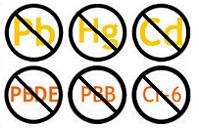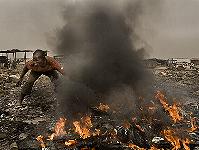Inadequately treated e-waste poses environmental and health risks. The original RoHS Directive (2002/95/EC), concerning the Restriction of Hazardous Substances in Electrical and Electronic Equipment (EEE), was adopted by the EU in February 2003 and brought into force 1st of July 2006 to limit the concentrations of hazardous substances found in EEE. This is because they are harmful to the environment, especially when - as in the past especially - they were often found in EEE that was dumped in landfills at the end of life. Since 1st July 2006 it has been unlawful to place any new EEE on the EU market containing more than certain permitted levels of lead, mercury, hexavalent chromium, cadmium, polybrominated biphenyls and polybrominated diphenyl ethers. Now, the RoHS Directive has been re-cast to become Directive 2011/65/EU (RoHS II), and Member States now have 18 months to transpose the new rules. Here, James Hunt explains the basics of it and how it differs from the previous incarnation of the RoHS directive:

Closely related to the Waste from Electrical and Electronic Equipment Directive (2002/96/EC - WEEE) the RoHS Directive regulates hazardous substances in EEE while WEEE regulates the disposal of that EEE.
About RoHS II:
In December 2008 the EU Commission issued its proposal for a re-cast of the existing ROHS Directive in order to tackle the fast increasing waste stream of such products. The reasons for the re-cast are to increase the amount of e-waste that is properly treated and to reduce the volume being disposed. Other important aims are to ensure coherence with newer policies and legislation (e.g. chemicals and the new legislative framework for the marketing of products in the EU), as well as to reduce administrative burdens. RoHS II was published in the Official Journal on 1 July 2011.
RoHS II is an updated version of RoHS. While there are no additions to the six restricted substances, so that it will continue to ban lead, mercury, cadmium, hexavalent chromium and the flame retardants Polybrominated biphenyls (PBB) and Polybrominated diphenyl ethers (PBDE), the ban on these chemicals in EEE has now been extended to a much wider range of products. Where there are alternatives available it is not acceptable to expose people or the planet to dangerous substances.
RoHS2 will work closely with REACH. Controlled substances such as HBCDD, DEHP, BBP and DBP by REACH might also be added to RoHS II list in the future.
The previous RoHS Directive covered several categories of electrical and electronic equipment including household appliances, IT and consumer equipment, but it has now been extended to all electronic equipment, cables and spare parts. Exemptions can still be granted in cases where no satisfactory alternative is available. RoHS II will, therefore, improve the safety of a great many other devices, including thermostats, medical devices and control panels, and will prevent the release of such hazardous substances into the environment. In this way, RoHS II will improve consumer safety, health and environmental protection, and the way in which the rules will work at national level. The list of banned substances will be reviewed on a regular basis.
The important parts of RoHS II are as follows:
- A gradual extension of the rules to all EEE, cables and spare parts, with a view to full compliance by 2019
- A review of the list of banned substances by July 2014, and periodically afterwards
- Clearer and more transparent rules for granting exemptions from the substance ban
- Improved coherence with the REACH Regulation on the Registration, Evaluation, Authorisation and Restriction of Chemicals
- Clarification of important definitions
- CE marking denoting compliance with European norms reserved for electronic products that also respect RoHS requirements.
Because of this significant extension in scope, RoHS allows transition periods of up to eight years for the new products affected by the rules.
RoHS II exemptions:
RoHS II exempts various types of electrical and electronic equipment. One such is solar photovoltaic (solar PV) panels, which are exempt to help the EU reach its renewable energy and energy efficiency objectives. Others include equipment essential to the security and protection of Member States, including arms, munitions and war materials intended specifically for military use, equipment designed to be sent into space, large scale stationary industrial tools and similar. Besides these general exempt EEE, there are certain specific exemptions of restricted substances in specific applications.
CE marking:
RoHS II is a CE Mark Directive, so CE marking must be fixed to all finished products, as per Module A of Annex II of 768/2008/CE. The responsibility is now shared between manufacturers and importers and distributors. CE declaration remains the manufacturer's obligation, while the release of compliant products onto the EU market becomes the responsibility of importers and distributors.
Note that the WEEE Directive has also been re-cast - see elsewhere in this VoltiTECH.
What does it mean for electrical contractors' and installers' working practices? Well, not a great deal (apart from ensuring that you use properly compliant non-counterfeit CE marked EEE at all times), but it is important to know the rules. In some cases, you will also be involved in returning EEE for proper disposal at end of life, but that is the province of the closely related WEEE Directive - see elsewhere in this VoltiTECH. Finally, RoHS 11 will provide a better environment for yourselves, your families and your working environment.
For information, go to:
http://eur-lex.europa.eu/LexUriServ/LexUriServ.do?uri=OJ:L:2011:174:0088:0110:EN:PDF
And:
http://ec.europa.eu/environment/waste/rohs_eee/index_en.htm
Also see Alastair Ramsay's article elsewhere in this VoltiTECH.
